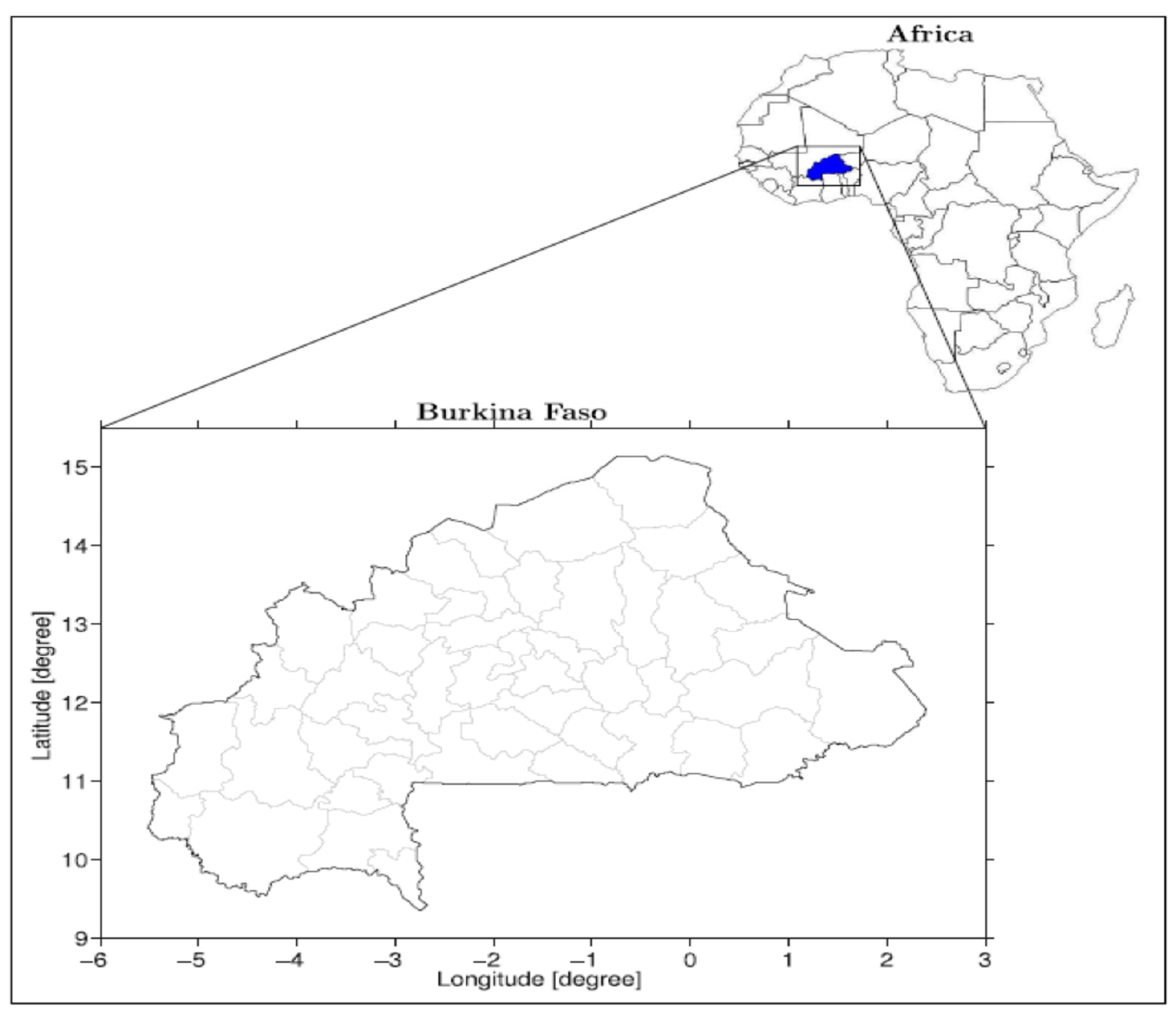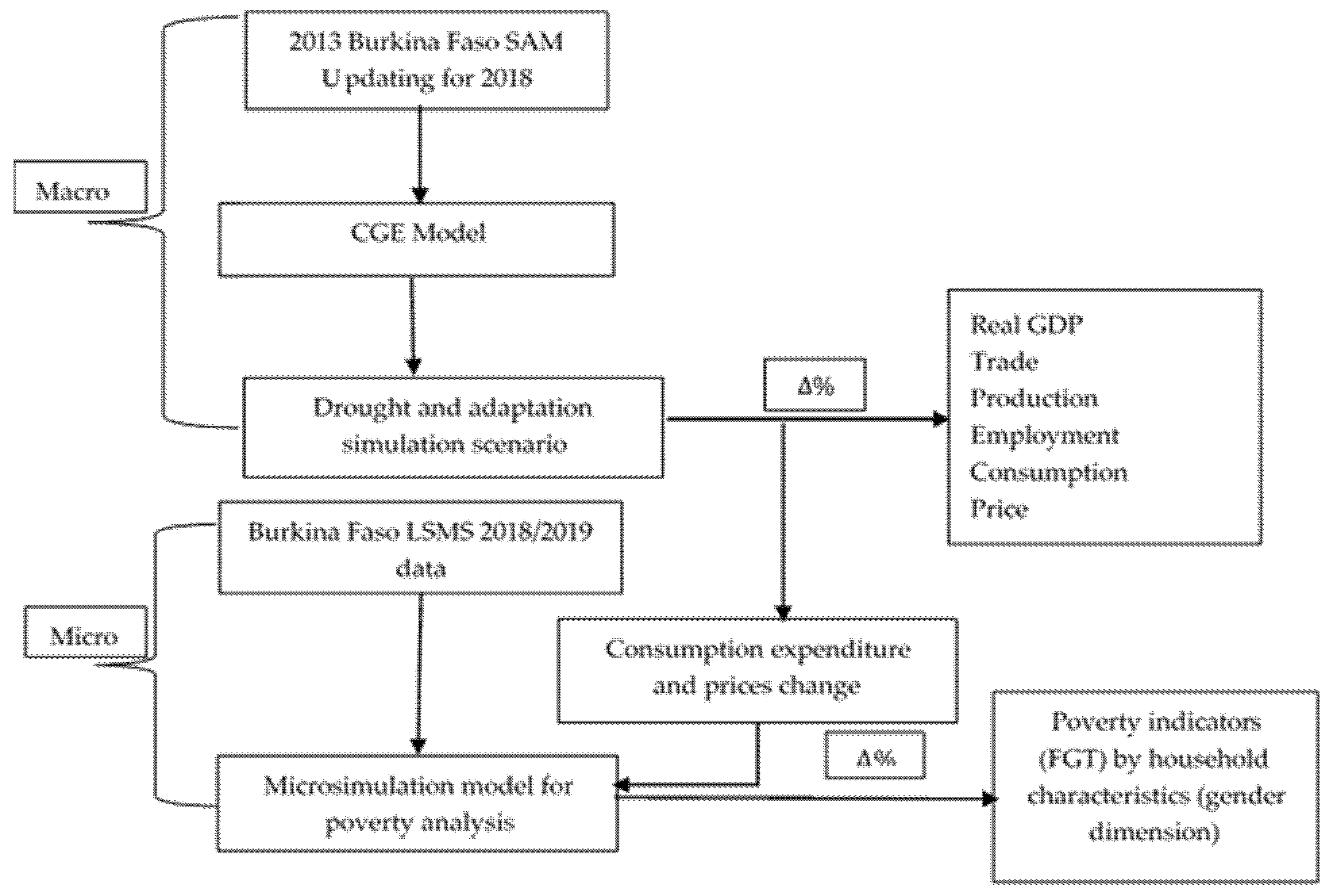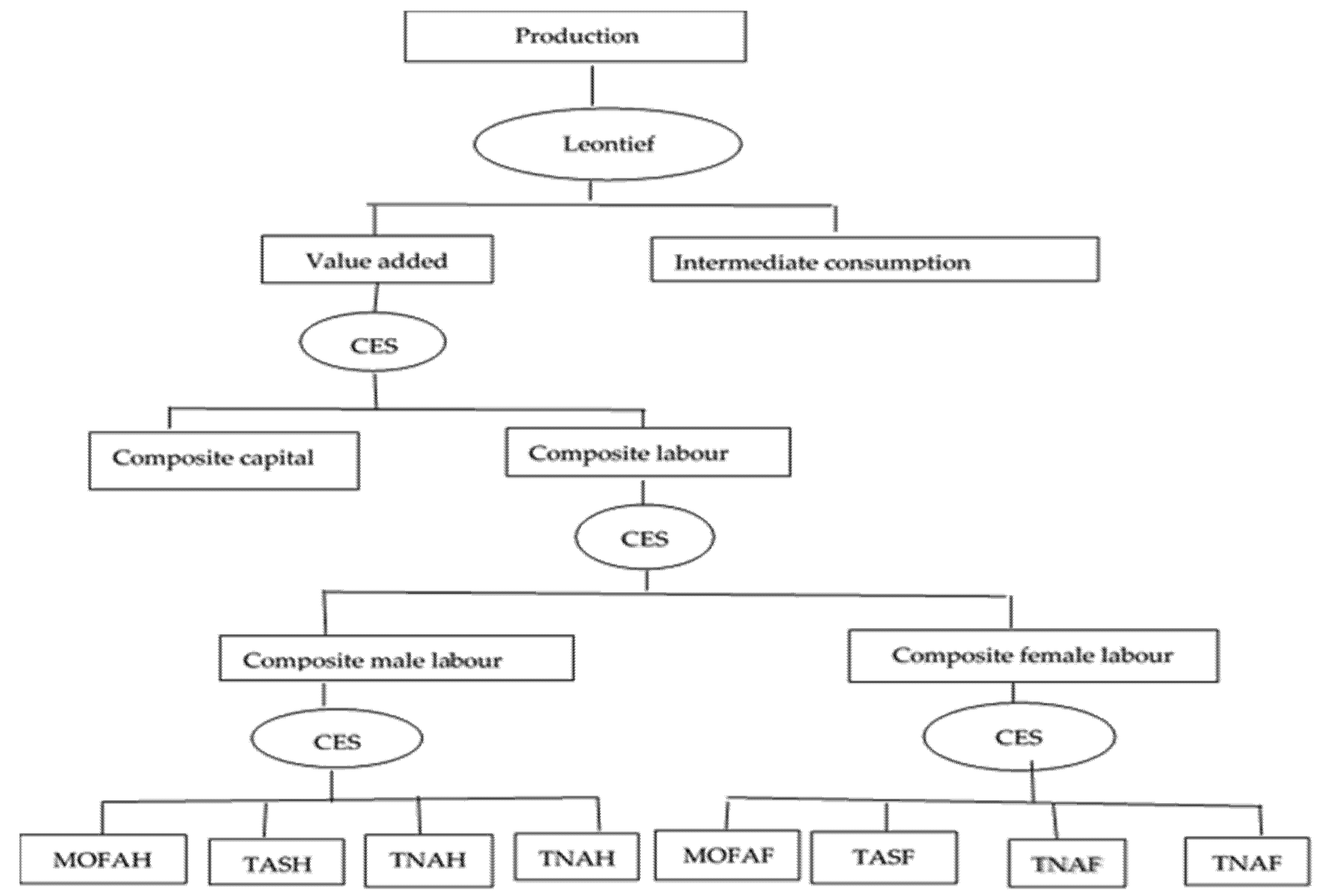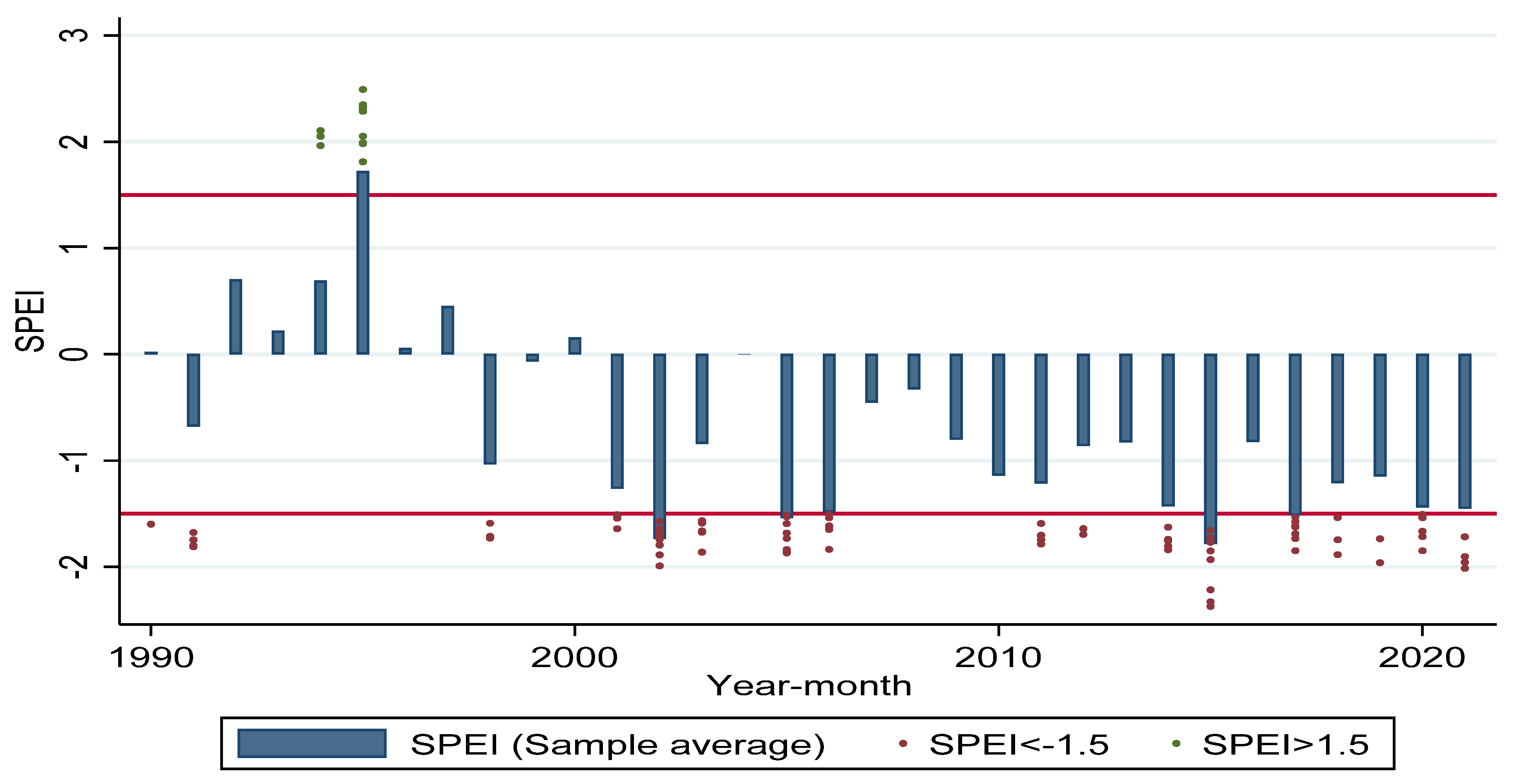Drought Impacts on the Crop Sector and Adaptation Options in Burkina Faso: A Gender-Focused Computable General Equilibrium Analysis
Abstract
1. Introduction
2. Study Area
3. Model and Data
3.1. Macro–Micro Analysis Framework and Data Sources
3.2. Data
3.3. Simulation Scenario Assumption
4. Results and Discussion
4.1. Impact of Drought on Burkina Faso’s Economy
4.1.1. Macroeconomic and Sectorial Impacts of Drought
4.1.2. Sectoral Results
4.1.3. Impacts of Drought on Income and Poverty
4.2. Drought Adaptation Strategies Impact Socioeconomic Indicators
5. Conclusions
Funding
Institutional Review Board Statement
Informed Consent Statement
Data Availability Statement
Acknowledgments
Conflicts of Interest
References
- IPCC. Climate Change 2014 Impacts, Adaptation, and Vulnerability. In Working Group II Contribution to the Fifth Assessment Report of the Intergovernmental Panel on Climate Change; Technical Report; Cambridge University Press: Cambridge, UK; New York, NY, USA, 2014; ISBN 9789291691418. [Google Scholar]
- Hsiang, S.; Kopp, R.E. An Economist’s Guide to Climate Change Science. J. Econ. Perspect. 2018, 32, 3–32. [Google Scholar] [CrossRef]
- IPCC. Climate Change 2013: The Physical Science Basis; Cambridge University Press: Cambridge, UK; New York, NY, USA, 2013. [Google Scholar]
- Mera, G.A. Drought and its impacts in Ethiopia. Weather Clim. Extrem. 2018, 22, 24–35. [Google Scholar] [CrossRef]
- Nguyen, T.T.; Nguyen, T.-T.; Le, V.-H.; Managi, S.; Grote, U. Reported weather shocks and rural household welfare: Evidence from panel data in Northeast Thailand and Central Vietnam. Weather Clim. Extrem. 2020, 30, 100286. [Google Scholar] [CrossRef]
- Reynaud, A.; Nguyen, M.-H.; Aubert, C. Is there a demand for flood insurance in Vietnam? Results from a choice experiment. Environ. Econ. Policy Stud. 2018, 20, 593–617. [Google Scholar] [CrossRef]
- Twongyirwe, R.; Mfitumukiza, D.; Barasa, B.; Naggayi, B.R.; Odongo, H.; Nyakato, V.; Mutoni, G. Perceived effects of drought on household food security in South-western Uganda: Coping responses and determinants. Weather Clim. Extrem. 2019, 24, 100201. [Google Scholar] [CrossRef]
- Flatø, M.; Muttarak, R.; Pelser, A. Women, Weather, and Woes: The Triangular Dynamics of Female-Headed Households, Economic Vulnerability, and Climate Variability in South Africa. World Dev. 2017, 90, 41–62. [Google Scholar] [CrossRef]
- Urama, N.E.; Eboh, E.C.; Onyekuru, A. Impact of extreme climate events on poverty in Nigeria: A case of the 2012 flood. Clim. Dev. 2019, 11, 27–34. [Google Scholar] [CrossRef]
- World Bank. World Development Report 2012: Gender Equity and Development; World Bank: Washington, DC, USA, 2012. [Google Scholar]
- Brown, C.; Meeks, R.; Hunu, K.; Yu, W. Hydroclimate risk to economic growth in sub-Saharan Africa. Clim. Change 2011, 106, 621–647. [Google Scholar] [CrossRef]
- Jury, M.R. Economic Impacts of Climate Variability in South Africa and Development of Resource Prediction Models. J. Appl. Meteorol. 2002, 41, 46–55. [Google Scholar] [CrossRef]
- Shiferaw, B.; Tesfaye, K.; Kassie, M.; Abate, T.; Prasanna, B.M.; Menkir, A. Managing vulnerability to drought and enhancing livelihood resilience in sub-Saharan Africa: Technological, institutional and policy options. Weather Clim. Extrem. 2014, 3, 67–79. [Google Scholar] [CrossRef]
- Masih, I.; Maskey, S.; Mussá, F.E.F.; Trambauer, P. A review of droughts on the African continent: A geospatial and long-term perspective. Hydrol. Earth Syst. Sci. 2014, 18, 3635–3649. [Google Scholar] [CrossRef]
- Montaud, J.M. Agricultural drought impacts on crops sector and adaptation options in Mali: A macroeconomic computable general equilibrium analysis. Environ. Dev. Econ. 2019, 24, 506–528. [Google Scholar] [CrossRef]
- Pauw, K.; Thurlow, J.; Bachu, M.; Van, D.E.; Pauw, K.; Thurlow, J.; Bachu, M.; Van, D.E. The economic costs of extreme weather events: A hydrometeorological CGE analysis for Malawi. Environ. Dev. Econ. 2011, 16, 177–198. [Google Scholar] [CrossRef]
- Crawford, A.; Price-Kelly, H.; Terton, A.; Echeverría, D. Review of Current and Planned Adaptation Action in Burkina Faso; CARIAA Working Paper no. 17. International Development Research Centre: Ottawa, Canada; UK Aid: London, United Kingdom. Available online: www.idrc.ca/cariaa (accessed on 10 December 2021).
- Traore, S.; Owiyo, T. Dirty droughts causing loss and damage in Northern Burkina Faso. Int. J. Glob. Warm. 2013, 5, 498–513. [Google Scholar] [CrossRef]
- Gautier, D.; Denis, D.; Locatelli, B. Impacts of drought and responses of rural populations in West Africa: A systematic review. Wiley Interdiscip. Rev. Clim. Change 2016, 7, 666–681. [Google Scholar] [CrossRef]
- Epule, E.T.; Peng, C.; Lepage, L.; Chen, Z. The causes, effects and challenges of Sahelian droughts: A critical review. Reg. Environ. Change 2014, 14, 145–156. [Google Scholar] [CrossRef]
- Lay, J.; Narloch, U.; Mahmoud, T.O. Shocks, Structural Change, and the Patterns of Income Diversification in Burkina Faso. Afr. Dev. Rev. 2009, 21, 36–58. [Google Scholar] [CrossRef]
- Dos Santos, S.; Henry, S. Rainfall variation as a factor in child survival in rural Burkina Faso: The benefit of an event-history analysis. Popul. Space Place 2008, 14, 1–20. [Google Scholar] [CrossRef]
- USAID. Climate risk profile: Climate risk in food for peace geographies Burkina Faso; USAID: Washington, DC, USA, 2017. [Google Scholar]
- Röhrig, F.; Murken, L.; Gornott, C.; Aschenbrenner, P.; Chemura, A.; Hattermann, F.; Koch, H.; Lehmann, J.; Liersch, S.; Schauberger, B.; et al. Climate Risk Analysis for Identifying and Weighing Adaptation Strategies for the Agricultural Sector in Burkina Faso. 2021. Available online: https://www.adaptationcommunity.net/publications/climate-risk-analysis-for-identifying-and-weighing-adaptation-strategies-in-burkina-fasos-agricultural-sector/ (accessed on 10 December 2021).
- World Bank. Climate-Smart Investment Plan for Burkina Faso (CSAIP); World Bank: Washington, DC, USA, 2019. [Google Scholar]
- MECV. Programme D’Action National D’Adaptation à la Variabilité Et Aux Changements Climatiques (PANA du Burkina Faso); MECV: Ouagadougou, Burkina Faso, 2007. [Google Scholar]
- IPCC. Managing the Risks of Extreme Events and Disasters to Advance Climate Change Adaptation: Special Report of the Intergovernmental Panel on Climate Change; Cambridge University Press: Cambridge, UK; New York, NY, USA, 2012. [Google Scholar]
- Goh, A.H.X. A Literature Review of the Gender-differentiated Impacts of Climate Change On Women’s and Men’s Assets and Well-Being in Developing Countries; CAPRi working papers No. 106; Int. Food Policy Res. Inst.: Washington, DC, USA, 2012. [Google Scholar]
- Huyer, S.; Simelton, E.; Chanana, N.; Mulema, A.; Marty, E. Expanding Opportunities: Scaling up Gender and Social Inclusion in Climate-Resilient Agriculture an Equality and Empowerment Approach. 2021. Available online: https://hdl.handle.net/10568/114223 (accessed on 10 December 2021).
- Walker, S.E.; Bruyere, B.L.; Solomon, J.N.; Powlen, K.A.; Yasin, A.; Lenaiyasa, E.; Lolemu, A. Pastoral coping and adaptation climate change strategies: Implications for women’s well-being. J. Arid Environ. 2022, 197, 104656. [Google Scholar] [CrossRef]
- Barbier, B.; Yacouba, H.; Karambiri, H.; Zoromé, M.; Somé, B. Human vulnerability to climate variability in the sahel: Farmers’ adaptation strategies in northern burkina faso. Environ. Manage. 2009, 43, 790–803. [Google Scholar] [CrossRef]
- Zorom, M.; Barbier, B.; Mertz, O.; Servat, E. Diversification and adaptation strategies to climate variability: A farm typology for the Sahel. Agric. Syst. 2013, 116, 7–15. [Google Scholar] [CrossRef]
- FEWSNET. A Climate Trend Analysis of Burkina Faso—Fact Sheet 2012–3084. In Famine Early Warning Systems Network—Informing Climate Change Adaptation Series; U.S. Department of the Interior: Washington, DC, USA, 2012. [Google Scholar]
- Andrijevic, M.; Crespo Cuaresma, J.; Lissner, T.; Thomas, A.; Schleussner, C.F. Overcoming gender inequality for climate resilient development. Nat. Commun. 2020, 11, 6261. [Google Scholar] [CrossRef]
- Kobiané, J.-F.; Ouili, I.; Guissou, S. Etat Des Lieux Des inégalités Multidimensionnelles Au Burkina Faso; Agence française de développement: Paris, France, 2020. [Google Scholar] [CrossRef]
- UNDP. Rapport Sur Le Développement Humain 2019: Les inégalités de Développement Humain Au XXIe Siècle; United Nation Development Progam (UNDP): Washington DC, USA, 2019. [Google Scholar]
- OECD-INSD-MFSNF. Burkina Faso: Étude pays SIGI. 2018. Available online: http://www.oecd.org/development/development-gender/ETUDE-PAYS-SIGI-BURKINA-FASO.pdf (accessed on 10 December 2021).
- INSD Enquête Nationale Sur L’Emploi et Secteur Informel (ENESI-2015): Chômage; Burkina Faso. 2016. Available online: http://www.insd.bf/contenu/enquetes_recensements/ENESI/Chomage.pdf (accessed on 10 December 2021).
- Corti, T.; Muccione, V.; Köllner-Heck, P.; Bresch, D.; Seneviratne, S.I. Simulating past droughts and associated building damages in France. Hydrol. Earth Syst. Sci. 2009, 13, 1739–1747. [Google Scholar] [CrossRef]
- Jenkins, K. Indirect economic losses of drought under future projections of climate change: A case study for Spain. Nat. Hazards 2013, 69, 1967–1986. [Google Scholar] [CrossRef]
- Freire-González, J.; Decker, C.; Hall, J.W. The Economic Impacts of Droughts: A Framework for Analysis. Ecol. Econ. 2017, 132, 196–204. [Google Scholar] [CrossRef]
- Horridge, M.; Madden, J.; Wittwer, G. The impact of the 2002–2003 drought on Australia. J. Policy Model. 2005, 27, 285–308. [Google Scholar] [CrossRef]
- Boyd, R.; Ibarraran, M.E. Extreme climate events and adaptation: An exploratory analysis of drought in Mexico. Environ. Dev. Econ. 2009, 14, 371–395. [Google Scholar] [CrossRef]
- Al-riffai, P.; Breisinger, C. Droughts in Syria: An Assessment of Impacts and Options for Improving the Resilience of the Poor. Q. J. Int. Agric. 2012, 51, 21–49. [Google Scholar]
- Bezabih, M.; Chambwera, M.; Stage, J.; Bezabih, M.; Chambwera, M.; Stage, J. Climate change and total factor productivity in the Tanzanian economy Climate change and total factor productivity in the Tanzanian economy. Clim. Policy 2016, 3062, 1289–1302. [Google Scholar] [CrossRef]
- Calzadilla, A.; Zhu, T.; Rehdanz, K.; Tol, R.S.J.; Ringler, C. Economywide impacts of climate change on agriculture in Sub-Saharan Africa. Ecol. Econ. 2013, 93, 150–165. [Google Scholar] [CrossRef]
- Gebreegziabher, Z.; Jesper, S.; Alemu, M.; Atlaw, A. Climate change and the Ethiopian economy: A CGE analysis. Environ. Dev. Econ. 2015, 21, 205–225. [Google Scholar] [CrossRef]
- Arndt, C.; Robinson, S.; Willenbockel, D. Ethiopia’s growth prospects in a changing climate: A stochastic general equilibrium approach. Glob. Environ. Chang. 2011, 21, 701–710. [Google Scholar] [CrossRef]
- Arndt, C.; Schlosser, A.; Strzepek, K. Climate Change and Economic Growth Prospects for Malawi: An Uncertainty Approach. J. Afr. Econ. 2015, 23, 83–107. [Google Scholar] [CrossRef]
- Montaud, J.M.; Pecastaing, N.; Tankari, M. Potential socio-economic implications of future climate change and variability for Nigerien agriculture: A countrywide dynamic CGE-Microsimulation analysis. Econ. Model. 2017, 63, 128–142. [Google Scholar] [CrossRef]
- Azoumah, Y.; Ramdé, E.W.; Tapsoba, G.; Thiam, S. Siting guidelines for concentrating solar power plants in the Sahel: Case study of Burkina Faso. Sol. Energy 2010, 84, 1545–1553. [Google Scholar] [CrossRef]
- Waongo, M.; Laux, P.; Kunstmann, H. Agricultural and Forest Meteorology Adaptation to climate change: The impacts of optimized planting dates on attainable maize yields under rainfed conditions in Burkina Faso. Agric. For. Meteorol. 2015, 205, 23–39. [Google Scholar] [CrossRef]
- Waongo, M. Optimizing Planting Dates for Agricultural Decision-Making under Climate Change over Burkina Faso/West Africa; University of Augsburg: Augsburg, Germany, 2015. [Google Scholar]
- McCarthy, N.; Kilic, T.; Brubaker, J.; Murray, S.; De La Fuente, A. Droughts and floods in Malawi: Impacts on crop production and the performance of sustainable land management practices under weather extremes. Environ. Dev. Econ. 2021, 26, 432–449. [Google Scholar] [CrossRef]
- Nübler, L.; Austrian, K.; Maluccio, J.A.; Pinchoff, J. Rainfall shocks, cognitive development and educational attainment among adolescents in a drought-prone region in Kenya. Environ. Dev. Econ. 2021, 26, 466–487. [Google Scholar] [CrossRef]
- Arndt, C.; Tarp, F. Who gets the goods? A general equilibrium perspective on food aid in Mozambique. Food Policy 2001, 26, 107–119. [Google Scholar] [CrossRef]
- Berrittella, M.; Hoekstra, A.Y.; Rehdanz, K.; Roson, R.; Tol, R.S.J. The economic impact of restricted water supply: A computable general equilibrium analysis. Water Res. 2007, 41, 1799–1813. [Google Scholar] [CrossRef]
- Bosello, F.; Roson, R.; Tol, R.S.J. Economy-wide estimates of the implications of climate change: Human health. Ecol. Econ. 2006, 58, 579–591. [Google Scholar] [CrossRef]
- Bosello, F.; Roson, R.; Tol, R.S.J. Economy-wide Estimates of the Implications of Climate Change: Sea Level Rise. Environ. Resour. Econ. 2007, 37, 549–571. [Google Scholar] [CrossRef]
- Carrera, L.; Standardi, G.; Bosello, F.; Mysiak, J. Assessing direct and indirect economic impacts of a flood event through the integration of spatial and computable general equilibrium modelling. Environ. Model. Softw. 2015, 63, 109–122. [Google Scholar] [CrossRef]
- Decaluwé, B.; Lemelin, A.; Robichaud, V.; Maisonnave, H. PEP-1-t. Standard PEP Model: Single-Country, Recursive Dynamic Version 2.1; Partnership for Economic Policy; Université Laval: Québec, QC, Canada, 2013. [Google Scholar]
- Chitiga-Mabugu, M.; Henseler, M.; Mabugu, R.; Maisonnave, H. The impact of the COVID-19 enforced lockdown and fiscal package on the South African economy and environment: A preliminary analysis. Environ. Dev. Econ. 2022, 27, 209–222. [Google Scholar] [CrossRef]
- Maisonnave, H.; Mamboundou, P.N. Agricultural economic reforms, gender inequality and poverty in Senegal. J. Policy Model. 2022, 44, 361–374. [Google Scholar] [CrossRef]
- MAAH. Matrice de Comptabilité Sociale (MCS) de 2013; MAAH: Ouagadougou, Burkina Faso, 2016. [Google Scholar]
- World Bank. World Development Indicators. 2021. Available online: https://datatopics.worldbank.org/world-development-indicators/ (accessed on 10 December 2021).
- Boeters, S.; Savard, L. The Labour Market in CGE Models. SSRN 2012. [Google Scholar] [CrossRef]
- Pissarides, C.A. Equilibrium Unemployment Theory, 2nd ed.; The MIT Press: Cambridge, MA, USA; London, UK, 1990; ISBN 0203883470. [Google Scholar]
- Shapiro, C.; Stiglitz, J.E. Unemployment as a Worker Discipline Device. Am. Econ. Rev. 1984, 74, 433–444. [Google Scholar] [CrossRef]
- McDonald, I.M.; Solow, R.M. Wage Bargaining and Employment. Am. Econ. Rev. 1981, 5, 151–174. [Google Scholar]
- Dissou, Y.; Sun, Q. GHG Mitigation Policies and Employment: A CGE Analysis with Wage Rigidity and Application to Canada. Can. Public Policy 2013, 39, S53–S65. [Google Scholar] [CrossRef]
- Blanchflower, D.G.; Oswald, A.J. An Introduction to the Wage Curve. J. Econ. Perpect. 1995, 9, 153–167. [Google Scholar] [CrossRef]
- Blanchflower, D.G.; Oswald, A.G. The Wage Curve; The MIT Press: Cambridge, MA, USA; London, UK, 1989. [Google Scholar]
- Decaluwe, B.; Lemelin, A.; Bahan, D.; Annabi, N. Taxation et mobilite partielle du capital dans un modele d’equilibre general calculable statique biregional du Quebec et du reste du Canada. L’Actual. Econ. D’Anal. Econ. 2011, 87, 175–203. [Google Scholar] [CrossRef][Green Version]
- Jung, H.S.; Thorbecke, E. The impact of public education expenditure on human capital, growth, and poverty in Tanzania and Zambia: A general equilibrium approach. J. Policy Model. 2003, 25, 701–725. [Google Scholar] [CrossRef]
- FAO. Food Security: Changing Policy Concepts of Food Security; FAO: Rome, Italy, 2006. [Google Scholar]
- Boeters, S.; Savard, L. The Labour Market in CGE Models. ZEW—Centre for European Economic Research Discussion Paper No. 11-079. 2011. Available online: https://papers.ssrn.com/sol3/papers.cfm?abstract_id=1987650 (accessed on 10 December 2021).
- INSD. Enquete Harmonisée Sur Les Conditions de Vie des Ménages (EHCVM-2018): Rapport D’Analyse; Institut National de la Statistique et de la Démographie (INSD): Ouagadougou, Burkina Faso, 2020. [Google Scholar]
- Cockburn, J.; Maisonnave, H.; Robichaud, V.; Tiberti, L. Fiscal space and public spending on children in Burkina Faso. Int. J. Microsimulation 2016, 9, 24–54. [Google Scholar] [CrossRef]
- Thornton, P.; Jones, P.; Owiyo, T.; Kruska, R.; Herrero, M.; Kristjanson, P.; Notenbaert, A.; Bekele, N.; Orindi, V.; Otiende, B.; et al. Mapping climate vulnerability and poverty in Africa. Rep. Dep. Int. Dev. ILRI PO Box 2006, 30709, 171. Available online: http://0-search.ebscohost.com.catalog.library.colostate.edu/login.aspx?direct=true&AuthType=cookie,ip,url,cpid&custid=s4640792&db=lah&AN=20073285958&site=ehost-live (accessed on 10 December 2021).
- Kazianga, H.; Udry, C. Consumption smoothing? Livestock, insurance and drought in rural Burkina Faso. J. Dev. Econ. 2006, 79, 413–446. [Google Scholar] [CrossRef]
- Kambou, D. Évaluation Des Performances Techniques de L’Irrigation Au Burkina Faso; University of Liège: Liège, Belgium, 2019; Volume 166. [Google Scholar]




| Short Term | Long Term | |||||
|---|---|---|---|---|---|---|
| Intense | Moderate | Mild | Intense | Moderate | Mild | |
| Economic indicators | ||||||
| Real GDP | −3.0 | −2.1 | −1.3 | −3.3 | −2.4 | −1.4 |
| Total Investment | −4.6 | −1.8 | 0.7 | −4.2 | −1.1 | 1.5 |
| Consumer price index | 2.7 | 1.5 | 0.5 | 3.5 | 2.1 | 0.6 |
| Employment | −1.5 | −1.1 | −0.6 | −1.9 | −1.2 | −0.6 |
| Households’ welfare indicators | ||||||
| Real household consumption | ||||||
| Rural households | −1.5 | −1.0 | −0.6 | −1.9 | −1.4 | −0.9 |
| Urban households | −3.4 | −2.4 | −1.5 | −3.8 | −2.7 | −1.4 |
| Food access per capita | ||||||
| Rural households | −4.1 | −3.0 | −2.1 | −4.5 | −3.2 | −1.7 |
| Urban households | −4.1 | −2.6 | −1.1 | −3.7 | −2.4 | −0.5 |
| Food availability per capita | ||||||
| Rural households | −10.4 | −7.3 | −4.6 | −11.1 | −7.5 | −4.0 |
| Urban households | −8.8 | −5.9 | −3.3 | −9.2 | −5.8 | −2.6 |
| Sectors | Short Term | Long Term | ||||
|---|---|---|---|---|---|---|
| Intense | Moderate | Mild | Intense | Moderate | Mild | |
| Production | ||||||
| Agriculture | −9.5 | −6.7 | −4.2 | −10.2 | −6.9 | −3.7 |
| Industry | −0.8 | −0.4 | 0.0 | −1.2 | −0.7 | −0.3 |
| Service | −1.1 | −0.9 | −0.6 | −1.4 | −1.1 | −0.8 |
| Exports | ||||||
| Agriculture | −28.0 | −19.0 | −10.6 | −29.1 | −18.5 | −8.2 |
| Industry | 0.3 | 0.8 | 1.3 | 0.8 | 1.3 | 1.8 |
| Service | −0.3 | 0.4 | 1.3 | −1.2 | −0.4 | 0.4 |
| Imports | ||||||
| Agriculture | 28.2 | 17.5 | 8.3 | 27.8 | 16.5 | 4.3 |
| Industry | −2.1 | −1.4 | −0.8 | −1.8 | −1.2 | −0.6 |
| Service | −4.8 | −3.0 | −1.5 | −4.3 | −2.2 | −0.2 |
| Population Groups | BAU | Short Term | Long Term | ||||
|---|---|---|---|---|---|---|---|
| Intense | Moderate | Mild | Intense | Moderate | Mild | ||
| Headcount Poverty (P0) | |||||||
| Areas | |||||||
| -Urban | 13.2 | 18.4 | 14.8 | 12.2 | 62.1 | 31.1 | 10.9 |
| -Rural | 51.1 | 61.7 | 55.8 | 49.5 | 94.0 | 76.3 | 45.4 |
| Household head gender | |||||||
| -Male | 42.3 | 51.8 | 46.3 | 40.8 | 86.5 | 65.9 | 37.2 |
| -Female | 32.8 | 38.8 | 35.3 | 31.6 | 80.0 | 52.9 | 30.0 |
| Population | 41.4 | 50.6 | 45.3 | 39.9 | 85.8 | 64.7 | 36.6 |
| Poverty gap (P1) | |||||||
| Areas | |||||||
| -Urban | 3.3 | 4.9 | 3.9 | 3.1 | 23.8 | 9.1 | 2.7 |
| -Rural | 15.3 | 20.5 | 17.3 | 14.4 | 52.1 | 31.0 | 12.9 |
| Household head gender | |||||||
| -Male | 12.4 | 16.8 | 14.1 | 11.6 | 45.5 | 25.9 | 10.4 |
| -Female | 10.9 | 14.1 | 12.1 | 10.4 | 38.5 | 21.1 | 9.5 |
| Population | 12.2 | 16.5 | 13.9 | 11.5 | 44.8 | 25.4 | 10.3 |
| Poverty severity (P2) | |||||||
| Areas | |||||||
| -Urban | 1.3 | 1.9 | 1.5 | 1.1 | 11.8 | 3.8 | 1.0 |
| -Rural | 6.3 | 9.0 | 7.3 | 5.8 | 32.4 | 15.5 | 5.1 |
| Household head gender | |||||||
| -Male | 5.0 | 7.3 | 5.8 | 4.6 | 27.5 | 12.7 | 4.0 |
| -Female | 4.8 | 6.6 | 5.5 | 4.5 | 22.9 | 10.8 | 4.0 |
| Population | 5.0 | 7.2 | 5.8 | 4.6 | 27.1 | 12.5 | 4.0 |
| 2022 | 2025 | 2030 | 2035 | 2040 | |
|---|---|---|---|---|---|
| Agricultural productivity change | 6% | 9% | 15% | 21% | 27% |
| Real GDP | −2.6 | −2.0 | −0.8 | 0.2 | 1.3 |
| Total Investment | −1.7 | −0.8 | 0.3 | 1.1 | 1.9 |
| Consumer price index | 2.1 | 1.7 | 0.9 | 0.1 | −0.7 |
| Employment | −1.4 | −1.1 | −0.5 | 0.1 | 0.6 |
| Food access per capita | |||||
| Rural households | −3.8 | −2.8 | −1.1 | 0.6 | 2.3 |
| Urban households | −3.0 | −2.1 | −0.6 | 0.9 | 2.4 |
| Food availability per capita | |||||
| Rural households | −9.0 | −6.7 | −2.6 | 1.6 | 5.8 |
| Urban households | −7.1 | −5.2 | −1.9 | 1.5 | 5.0 |
| Poverty rate by household head gender | |||||
| Male-headed households | 37.8 | 32.0 | 22.0 | 13.9 | 8.6 |
| Female-headed households | 30.2 | 26.0 | 20.1 | 13.5 | 9.6 |
| 2022 | 2025 | 2030 | 2035 | 2040 | |
|---|---|---|---|---|---|
| Productivity growth change | 4% | 7% | 11% | 16% | 20% |
| Real GDP | −3.0 | −2.5 | −1.6 | −0.8 | 0.1 |
| Total Investment | −2.1 | −1.2 | −0.4 | 0.2 | 0.8 |
| Consumer price index | 2.4 | 2.2 | 1.5 | 0.8 | 0.2 |
| Employment | −1.6 | −1.3 | −0.9 | −0.4 | 0.0 |
| Food access per capita | |||||
| Rural households | −4.3 | −3.6 | −2.3 | −0.9 | 0.3 |
| Urban households | −3.4 | −2.6 | −1.5 | −0.5 | 0.6 |
| Food availability per capita | |||||
| Rural households | −10.0 | −8.3 | −5.3 | −2.2 | 0.9 |
| Urban households | −7.9 | −6.5 | −4.1 | −1.7 | 0.9 |
| Poverty rate by household head gender | |||||
| Male-headed households | 38.0 | 32.2 | 22.5 | 14.2 | 9.1 |
| Female-headed households | 30.3 | 26.0 | 20.5 | 13.6 | 10.2 |
| 2022 | 2025 | 2030 | 2035 | 2040 | |
|---|---|---|---|---|---|
| Agricultural productivity change | 8% | 14% | 22% | 31% | 39% |
| Real GDP | −2.0 | −1.1 | 0.4 | 1.8 | 3.1 |
| Total Investment | −1.1 | 0.1 | 1.4 | 2.6 | 3.8 |
| Consumer price index | 1.7 | 1.1 | 0.1 | −0.9 | −1.7 |
| Employment | −1.1 | −0.6 | 0.1 | 0.8 | 1.3 |
| Food access per capita | |||||
| Rural households | −3.1 | −1.6 | 0.8 | 3.2 | 5.5 |
| Urban households | −2.3 | −1.0 | 1.2 | 3.3 | 5.4 |
| Food availability per capita | |||||
| Rural households | −7.2 | −3.8 | 2.1 | 8.2 | 14.2 |
| Urban households | −5.7 | −2.9 | 2.0 | 7.0 | 12.1 |
| Poverty rate by household head gender | |||||
| Male-headed households | 37.4 | 31.7 | 21.5 | 13.7 | 8.5 |
| Female-headed households | 30.2 | 25.4 | 19.9 | 13.5 | 9.1 |
Publisher’s Note: MDPI stays neutral with regard to jurisdictional claims in published maps and institutional affiliations. |
© 2022 by the author. Licensee MDPI, Basel, Switzerland. This article is an open access article distributed under the terms and conditions of the Creative Commons Attribution (CC BY) license (https://creativecommons.org/licenses/by/4.0/).
Share and Cite
Sawadogo, B. Drought Impacts on the Crop Sector and Adaptation Options in Burkina Faso: A Gender-Focused Computable General Equilibrium Analysis. Sustainability 2022, 14, 15637. https://doi.org/10.3390/su142315637
Sawadogo B. Drought Impacts on the Crop Sector and Adaptation Options in Burkina Faso: A Gender-Focused Computable General Equilibrium Analysis. Sustainability. 2022; 14(23):15637. https://doi.org/10.3390/su142315637
Chicago/Turabian StyleSawadogo, Boureima. 2022. "Drought Impacts on the Crop Sector and Adaptation Options in Burkina Faso: A Gender-Focused Computable General Equilibrium Analysis" Sustainability 14, no. 23: 15637. https://doi.org/10.3390/su142315637
APA StyleSawadogo, B. (2022). Drought Impacts on the Crop Sector and Adaptation Options in Burkina Faso: A Gender-Focused Computable General Equilibrium Analysis. Sustainability, 14(23), 15637. https://doi.org/10.3390/su142315637




